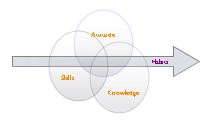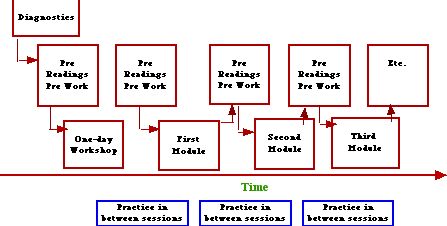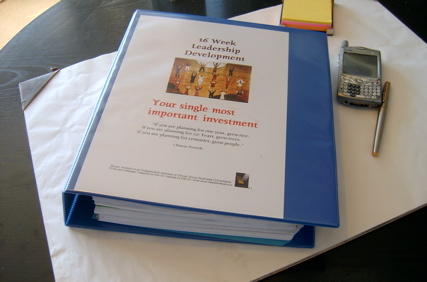
Contact Manager
Phone:
+64 21 620 456
16 Kauri Street, Woburn, Hutt City, New Zealand
email:
Manager@virtual.co.nz
 |
Breaking down silos - Where to start
To break down silos, in our program, we normally have to address all of the ten components.
The best place to start always depends on the diagnostics, including your major problems, your skills and experience and what has already been tried. However, because the blame for silos and politics belongs at the top of the organisation, I have usually found that the best place to start is by working with the senior 20 or 30 managers; building their strength, developing their trust of each other; increasing their level of connection and giving them tools to lead and empower their people more effectively.
The Leadership component

We have found that a modular approach is the most effective because it allows time for people to change habits. One-hit programs nearly always disappoint because it takes at least 3 months to change behaviours (habits); and usually we need to change several.
The aim is to provide enough time for people to change the habits of a lifetime. We need to work on attitudes (want to), knowledge (what to) and skills (how to):
We have found that the best results are achieved by regular short (3 to 4 hour) modules every couple of weeks. This produces lasting results without killing the budget and the participants.

In the program people usually start off not knowing that they have a problem, after a period they start to become aware that they need to change, then they develop the attitudes, skills and knowledge to operate in the new way as long as they continue to think about it; finally they start to operate in the new way as though it was the natural way of doing things. These four steps towards change take time.
The modules are supported by readings and exercises in between the modules. The result is that people get 4 months development but the organisation only pays for about one week. And it all happens in your workplace, on your problems.
It looks like:

The rationale includes:
- Training does not stop during the gaps in between the workshops
- Gaps are used to test and trial theory
- Most of the work takes place in people's own time
- People practice using the theory in between modules making the program far more immediate and practical and real
- Content is mostly delivered outside the workshops as readings
- Workshops occur when people come together anyway.
A tyical Leadership Program
Managers can choose from 60+ modules but the most popular modules are...
Style
I have an innate belief in the wisdom of people when they are treated with respect. My style is non-threatening and supportive. I have worked with all levels from most senior managers to workers in overalls. I value simplicity and work to extract the essence and remove jargon.
In my experience people learn best when they are slightly outside their comfort zone. Training can be deadly dull or can be vibrant and exciting, the more vibrant you can make it the better the chance that you'll get something fresh and productive from the session.
Building on the positives
Appreciative inquiry (AI) is about starting with the positives - what's working well at present. If we start with the negatives we will end up in a totally different space. AI is based on the premise that "organisations change in the direction in which they inquire." So an organisation that inquires into problems will keep finding problems but an organisation that attempts to appreciate what is best in itself will discover more and more that is good. It can then use these discoveries to build a new future where the best becomes more common. AI shows that change is far easier, quicker and occurs with less resistance if we can capture and carry forward those things that are already working well.
Peer-to-peer
Peer-to-peer leadership development challenges some traditional assumptions about the training of future leaders. Instead of relying entirely on the wisdom of anointed experts, it assumes that people often learn best from peers who share the same daily struggles of front-liner like themselves.
Furthermore, peer conversations can provide emotional as well as practical support. Peer-to-peer replaces the one-way flow of information typical of training programs " the pour-and-snore approach" with fluid online conversations.
Flexibility
The modular approach allows greater flexibility so that changes can also be made depending on progress as we go. Whilst it is important that we have a plan for what we want to achieve, it's also important that we are prepared to change this plan if, once we are started, issues arise that were not expected. Changes are only made by mutual agreement.
If unexpected issues arise during the program, that other Virtual Group people have better skills in, I reserve the right to involve other members of the Virtual Group Business Consultants.
Prereading

Before each module, pre-workshop readings will be issued and exercises undertaken so that the most effective use can be made of the workshop time in facilitation-mode rather than teaching-mode. For example I try really hard not have an overhead projector or Power Point presentation in my workshops.
Information exchange will happen largely between modules rather than during the modules. Over the course of the training the readings, notes and practical exercises supplied by Virtual Group will grow into a highly valuable body of material for future reference. This is shown in the photograph.
In-house
In-house programs are more effective for the following reasons:
- All participants go through the same experience and therefore develop a common way of thinking and have a common set of expectations
- Participants learn together from each other
- Participants encourage and energise each other through sharing stories and positive experiences
- It increases peer pressure
- It's totally tailored to the needs of the participants
- Energy, focus and collaboration are strong by-products of the program.


